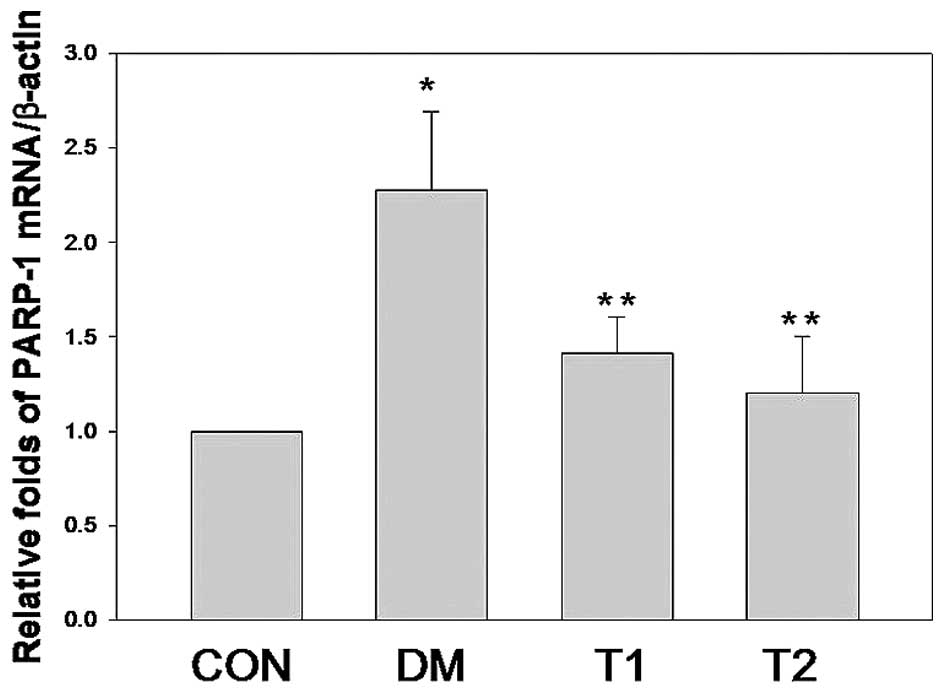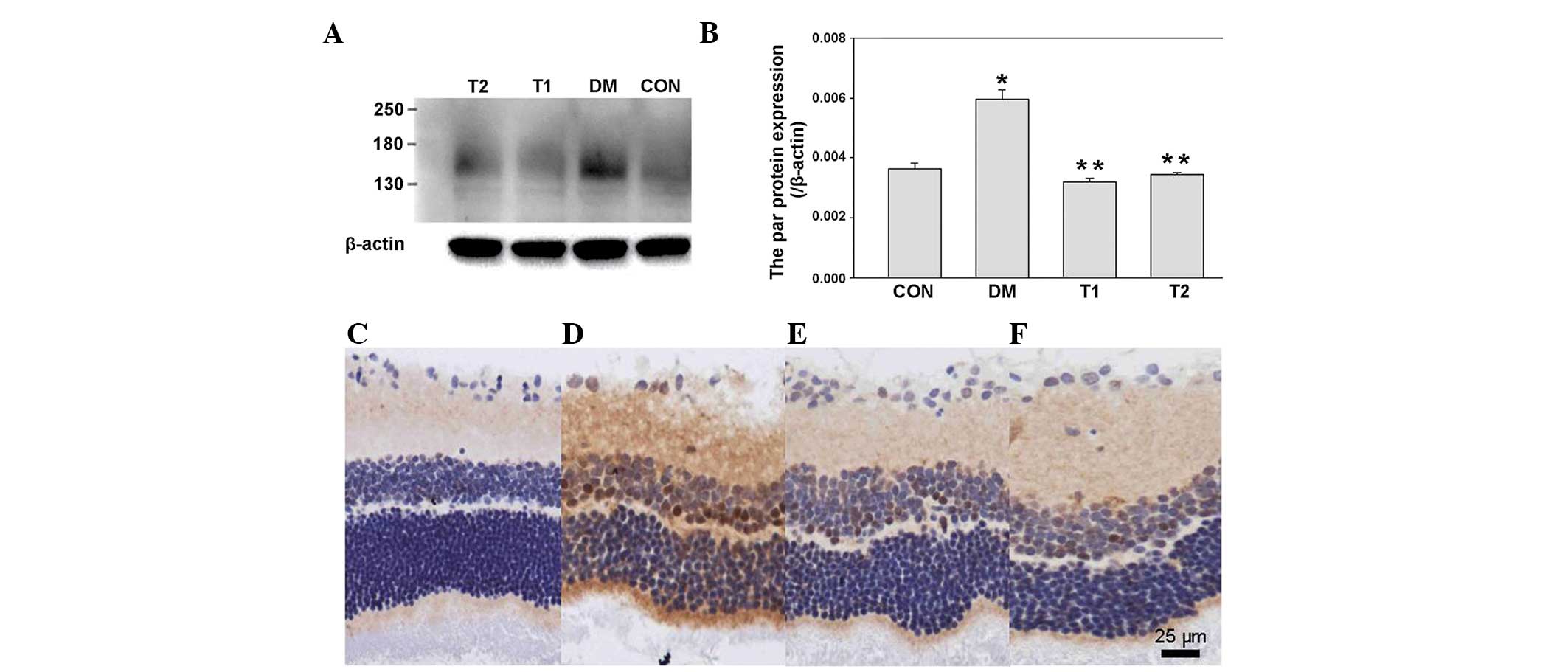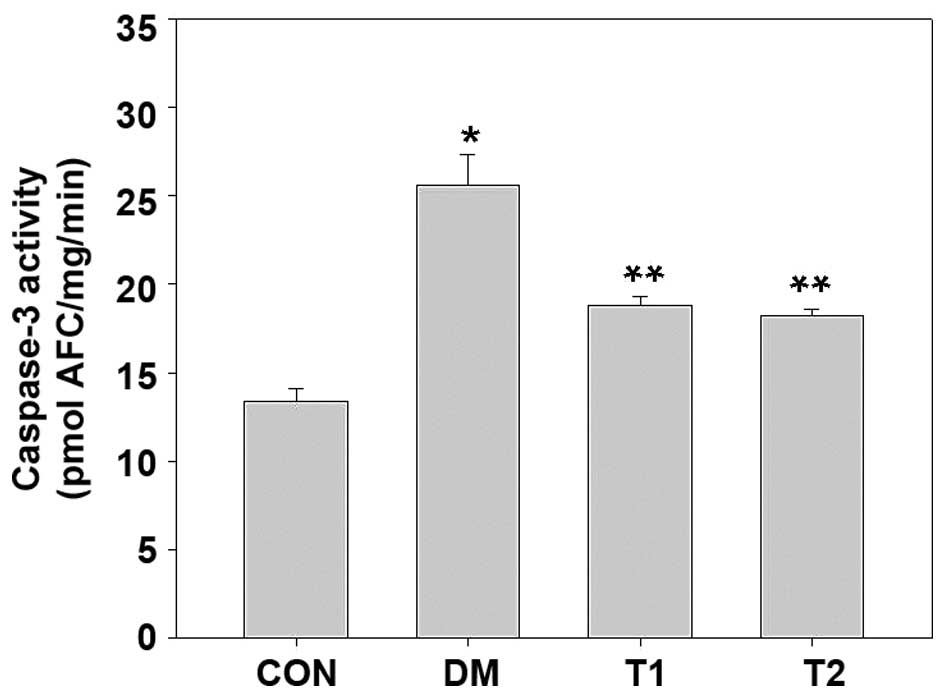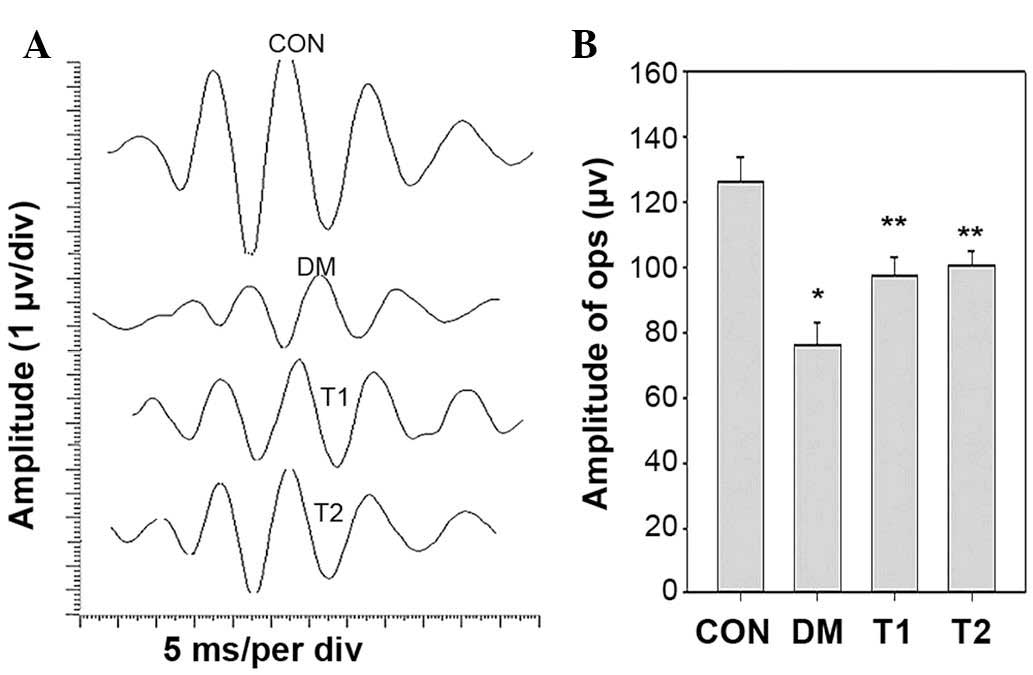|
1
|
Engerman RL and Kern TS: Retinopathy in
animal models of diabetes. Diabetes Metab Rev. 11:109–120. 1995.
View Article : Google Scholar : PubMed/NCBI
|
|
2
|
Mizutani M, Kern TS and Lorenzi M:
Accelerated death of retinal microvascular cells in human and
experimental diabetic retinopathy. J Clin Invest. 97:2883–2890.
1996. View Article : Google Scholar : PubMed/NCBI
|
|
3
|
Hammes HP, Federoff HJ and Brownlee M:
Nerve growth factor prevents both neuroretinal programmed cell
death and capillary pathology in experimental diabetes. Mol Med.
1:527–534. 1995.PubMed/NCBI
|
|
4
|
Barber AJ, Lieth E, Khin SA, Antonetti DA,
Buchanan AG and Gardner TW: Neural apoptosis in the retina during
experimental and human diabetes. Early onset and effect of insulin.
J Clin Invest. 102:783–791. 1998. View
Article : Google Scholar : PubMed/NCBI
|
|
5
|
Szabó C and Ohshima H: DNA damage induced
by peroxynitrite: Subsequent biological effects. Nitric Oxide.
1:373–385. 1997. View Article : Google Scholar
|
|
6
|
Szabó C and Dawson VL: Role of
poly(ADP-ribose) synthetase in inflammation and
ischaemia-reperfusion. Trends Pharmacol Sci. 19:287–298. 1998.
View Article : Google Scholar : PubMed/NCBI
|
|
7
|
Heller B, Wang ZQ, Wagner EF, Radons J,
Bürkle A, Fehsel K, Burkart V and Kolb H: Inactivation of the
poly(ADP-ribose) polymerase gene affects oxygen radical and nitric
oxide toxicity in islet cells. J Biol Chem. 270:11176–11180. 1995.
View Article : Google Scholar : PubMed/NCBI
|
|
8
|
Li GY, Fan B and Su GF: Acute energy
reduction induces caspase-dependent apoptosis and activates p53 in
retinal ganglion cells (RGC-5). Exp Eye Res. 89:581–589. 2009.
View Article : Google Scholar : PubMed/NCBI
|
|
9
|
Zheng L and Kern TS: Role of nitric oxide,
superoxide, peroxynitrite and PARP in diabetic retinopathy. Front
Biosci (Landmark Ed). 14:3974–3987. 2009. View Article : Google Scholar
|
|
10
|
Virág L and Szabó C: The therapeutic
potential of poly(ADP-ribose) polymerase inhibitors. Pharmacol Rev.
54:375–429. 2002. View Article : Google Scholar : PubMed/NCBI
|
|
11
|
Brownlee M: Biochemistry and molecular
cell biology of diabetic complications. Nature. 414:813–820. 2001.
View Article : Google Scholar : PubMed/NCBI
|
|
12
|
Yrjänheikki J, Tikka T, Keinänen R,
Goldsteins G, Chan PH and Koistinaho J: A tetracycline derivative,
minocycline, reduces inflammation and protects against focal
cerebral ischemia with a wide therapeutic window. Proc Natl Acad
Sci USA. 96:13496–13500. 1999. View Article : Google Scholar : PubMed/NCBI
|
|
13
|
Ryu JK, Franciosi S, Sattayaprasert P, Kim
SU and McLarnon JG: Minocycline inhibits neuronal death and glial
activation induced by beta-amyloid peptide in rat hippocampus.
Glia. 48:85–90. 2004. View Article : Google Scholar : PubMed/NCBI
|
|
14
|
Krady JK, Basu A, Allen CM, Xu Y, LaNoue
KF, Gardner TW and Levison SW: Minocycline reduces proinflammatory
cytokine expression, microglial activation, and caspase-3
activation in a rodent model of diabetic retinopathy. Diabetes.
54:1559–1565. 2005. View Article : Google Scholar : PubMed/NCBI
|
|
15
|
Vincent JA and Mohr S: Inhibition of
caspase-1/interleukin-1beta signaling prevents degeneration of
retinal capillaries in diabetes and galactosemia. Diabetes.
56:224–230. 2007. View Article : Google Scholar
|
|
16
|
Chang CJ, Cherng CH, Liou WS and Liao CL:
Minocycline partially inhibits caspase-3 activation and
photoreceptor degeneration after photic injury. Ophthalmic Res.
37:202–213. 2005. View Article : Google Scholar : PubMed/NCBI
|
|
17
|
Obrosova IG, Minchenko AG, Frank RN,
Seigel GM, Zsengeller Z, Pacher P, Stevens MJ and Szabó C:
Poly(ADP-ribose) polymerase inhibitors counteract diabetes- and
hypoxia-induced retinal vascular endothelial growth factor
overexpression. Int J Mol Med. 14:55–64. 2004.PubMed/NCBI
|
|
18
|
Santiago AR, Cristóvão AJ, Santos PF,
Carvalho CM and Ambrósio AF: High glucose induces
caspase-independent cell death in retinal neural cells. Neurobiol
Dis. 25:464–472. 2007. View Article : Google Scholar : PubMed/NCBI
|
|
19
|
Zhu B, Wang W, Gu Q and Xu X:
Erythropoietin protects retinal neurons and glial cells in
early-stage streptozotocin-induced diabetic rats. Exp Eye Res.
86:375–382. 2008. View Article : Google Scholar : PubMed/NCBI
|
|
20
|
Hotta N, Koh N, Sakakibara F, Nakamura J,
Hamada Y, Naruse K, Sasaki H, Mizuno K, Matsubara A, Kakuta H, et
al: Effect of an aldose reductase inhibitor, SNK-860, on deficits
in the electroretinogram of diabetic rats. Exp Physiol. 80:981–989.
1995. View Article : Google Scholar : PubMed/NCBI
|
|
21
|
Wurziger K, Lichtenberger T and Hanitzsch
R: On-bipolar cells and depolarising third-order neurons as the
origin of the ERG-b-wave in the RCS rat. Vision Res. 41:1091–1101.
2001. View Article : Google Scholar : PubMed/NCBI
|
|
22
|
Tzekov R and Arden GB: The
electroretinogram in diabetic retinopathy. Surv Ophthalmol.
44:53–60. 1999. View Article : Google Scholar : PubMed/NCBI
|
|
23
|
Ogden TE: The oscillatory waves of the
primate electroretinogram. Vision Res. 13:1059–1074. 1973.
View Article : Google Scholar : PubMed/NCBI
|
|
24
|
Wachtmeister L and Dowling JE: The
oscillatory potentials of the mudpuppy retina. Invest Ophthalmol
Vis Sci. 17:1176–1188. 1978.PubMed/NCBI
|
|
25
|
Li Q, Zemel E, Miller B and Perlman I:
Early retinal damage in experimental diabetes:
Electroretinographical and morphological observations. Exp Eye Res.
74:615–625. 2002. View Article : Google Scholar : PubMed/NCBI
|
|
26
|
Kline RP, Ripps H and Dowling JE:
Generation of b-wave currents in the skate retina. Proc Natl Acad
Sci USA. 75:5727–5731. 1978. View Article : Google Scholar : PubMed/NCBI
|
|
27
|
Klemp K, Sander B, Brockhoff PB, Vaag A,
Lund-Andersen H and Larsen M: The multifocal ERG in diabetic
patients without retinopathy during euglycemic clamping. Invest
Ophthalmol Vis Sci. 46:2620–2626. 2005. View Article : Google Scholar : PubMed/NCBI
|
|
28
|
Chen BH, Jiang DY and Tang LS: Advanced
glycation end-products induce apoptosis involving the signaling
pathways of oxidative stress in bovine retinal pericytes. Life Sci.
79:1040–1048. 2006. View Article : Google Scholar : PubMed/NCBI
|
|
29
|
Du Y, Miller CM and Kern TS: Hyperglycemia
increases mitochondrial superoxide in retina and retinal cells.
Free Radic Biol Med. 35:1491–1499. 2003. View Article : Google Scholar : PubMed/NCBI
|
|
30
|
Drel VR, Xu W, Zhang J, Kador PF, Ali TK,
Shin J, Julius U, Slusher B, El-Remessy AB and Obrosova IG:
Poly(ADP-ribose)polymerase inhibition counteracts cataract
formation and early retinal changes in streptozotocin-diabetic
rats. Invest Ophthalmol Vis Sci. 50:1778–1790. 2009. View Article : Google Scholar
|
|
31
|
Obrosova IG and Julius UA: Role for
poly(ADP-ribose) polymerase activation in diabetic nephropathy,
neuropathy and retinopathy. Curr Vasc Pharmacol. 3:267–283. 2005.
View Article : Google Scholar : PubMed/NCBI
|
|
32
|
Zheng L, Szabó C and Kern TS:
Poly(ADP-ribose) polymerase is involved in the development of
diabetic retinopathy via regulation of nuclear factor-kappaB.
Diabetes. 53:2960–2967. 2004. View Article : Google Scholar : PubMed/NCBI
|
|
33
|
Li GY and Osborne NN: Oxidative-induced
apoptosis to an immortalized ganglion cell line is caspase
independent but involves the activation of
poly(ADP-ribose)polymerase and apoptosis-inducing factor. Brain
Res. 1188:35–43. 2008. View Article : Google Scholar
|
|
34
|
Miki K, Uehara N, Shikata N, Matsumura M
and Tsubura A: Poly (ADP-ribose) polymerase inhibitor
3-aminobenzamide rescues N-methyl-N-nitrosourea-induced
photoreceptor cell apoptosis in Sprague-Dawley rats through
preservation of nuclear factor-kappaB activity. Exp Eye Res.
84:285–292. 2007. View Article : Google Scholar
|
|
35
|
Oku H, Goto W, Okuno T, Kobayashi T,
Sugiyama T, Ota T, Yoneda S, Hara H and Ikeda T: Effects of
poly(ADP-ribose) polymerase inhibitor on NMDA-induced retinal
injury. Curr Eye Res. 29:403–411. 2004. View Article : Google Scholar
|
|
36
|
Cukras CA, Petrou P, Chew EY, Meyerle CB
and Wong WT: Oral minocycline for the treatment of diabetic macular
edema (DME): Results of a phase I/II clinical study. Invest
Ophthalmol Vis Sci. 53:3865–3874. 2012. View Article : Google Scholar : PubMed/NCBI
|
|
37
|
Kraus RL, Pasieczny R, Lariosa-Willingham
K, Turner MS, Jiang A and Trauger JW: Antioxidant properties of
minocycline: Neuroprotection in an oxidative stress assay and
direct radical-scavenging activity. J Neurochem. 94:819–827. 2005.
View Article : Google Scholar : PubMed/NCBI
|
|
38
|
Choi SH, Lee DY, Chung ES, Hong YB, Kim SU
and Jin BK: Inhibition of thrombin-induced microglial activation
and NADPH oxidase by minocycline protects dopaminergic neurons in
the substantia nigra in vivo. J Neurochem. 95:1755–1765. 2005.
View Article : Google Scholar : PubMed/NCBI
|
|
39
|
Sinha-Hikim I, Shen R, Nzenwa I, Gelfand
R, Mahata SK and Sinha-Hikim AP: Minocycline suppresses oxidative
stress and attenuates fetal cardiac myocyte apoptosis triggered by
in utero cocaine exposure. Apoptosis. 16:563–573. 2011. View Article : Google Scholar : PubMed/NCBI
|
|
40
|
Cieslik M, Pyszko J and Strosznajder JB:
Docosahexaenoic acid and tetracyclines as promising neuroprotective
compounds with poly(ADP-ribose) polymerase inhibitory activities
for oxidative/genotoxic stress treatment. Neurochem Int.
62:626–636. 2013. View Article : Google Scholar : PubMed/NCBI
|














